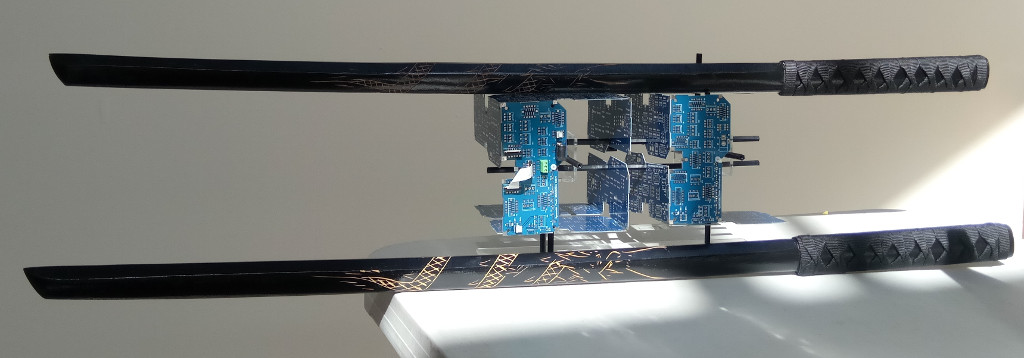|
Home Page
Six Transistor Cache
Investors
Launch Date
Contacts
Terms and Conditions
_________________________
|
Hypercube Humanoid Robots For AI Infused Contact Sports
Why Contact Sports?
- The exercise that can be gained from non contact sports such as dancing, or use of Bokken is limited.
- To fully exercise the mind and body you need a master that can train you in ways that are real to deal with real world physics and unpredictability.
- The difference is instinct built into every nerve fiber and synchronized action with all your other senses and muscles which is far more important for saving life if you are for example a police officer.
- When someone throws a ball in a dangerous way by mistake, I for one am fortunate to have hands instinctively reach out to block a dangerous projectile if it is determined to be dangerous. That is down to training. If someone had to think out all the details such as is too fast, should I block it, is it going to hit something, can I ignore it, then its of no use to anyone if someone got injured. This kind of skill does not come with learning to dance well or through non-contact sports. It has to be full on engagement through contact sports. Its not safe. I know friends who ended up in hospital as well as receive permanent scarring injury. But if we could do it safer with a Hypercube humanoid robot infused with AI, then we got our life long master that can train us with physical contact sports.
- This kind of advanced Humanoid robot and its market does not exist at present, but we hope to create it using 3D printed parts and with all the latest Hypercube Boards and software we are creating.
Hypercube Humanoid Robots
- A Hypercube humanoid robot suitable for contact sports will pack its chest and stomach areas with electronics and batteries.
- The boards and batteries are packed into 3D Hypercube format and wired in 3D.
- Additional batteries would be packed into the leg and arm cavities because the biggest issue for a street walking humanoid robot is keeping its batteries charged every hour.
- We use Hypercube Lithium charger boards to keep records on the battery usages and recharge whenever possible.
- We cover the Hypercube humanoid with solar cells to charge it while out in the sun. We may add a pair of folding wings on a back pack to allow it to unfurl a set of solar wings like an angel to capture energy.
- We may put into the wings our light weight MPDWE axle free motor to allow humanoid robot to re-balance if it falls, or even fly for about 5 seconds:)
- We fit induction power charger pads to many areas of the humanoid robot to allow it to charge power from different size of induction chargers (small, medium, large).
- As the humanoid is an autonomous system, we use autonomous mode power management - this means keeping back some batteries in charge mode so that the batteries are pre-prepared with its chemistry reversed to accept large amounts of charge wherever it can get it from as it passes by a power source.
- The bigger actuators are MPDWE motors and linear versions which is light on weight and returns a lot of unused power efficiently. We use an array of dual 100A H-bridge board capable of generating 5kW of instant mechanical power per board.
- The smaller actuators are electrostatic. We use the dual 100A H-bridge board to generate the high voltage with a step up transformer - enough to generate 5kW of instant mechanical power per board.
- All this mechanical power is to make the robot swift in contact sport, but if there is danger, the humanoid robot will switch operating mode and turn to catch you should you fall, or reverse/divert its blows to save you from injury if you did not block its moves.
- The robot has at least 2 cameras - each capable of taking at least one picture per second and remembering everything for a decade or more using high capacity disk arrays powered by Hypercube servers boards.
- There is running behind the imaging system an AI system that is constantly analyzing pictures using our latest Hyper Neural Net AI system.
- Along with the cameras, there are numerous sensors such as PIR heat sensors on the body, g sensors to sense sudden movements and shock, water incursion sensors, internal thermal sensors, gas sensors, and so on.
- The robot will get bigger with more features added, but not likely to exceed 2x size of a tall human with present day technology.
- The bigger humanoid, the better for packing it with more sensors, computing power and memories, but more slow and clumsy it could become.
- Instead of making clumsy robots, we think our humanoids should attend AI dancing lessons and be capable of imitating this fluidly https://www.youtube.com/watch?v=MJAfILhgdeA :)
- AI Healthcare
- arm-none-eabi-objcopy -O ihex ${ProjName}.elf ${ProjName}.hex
|

